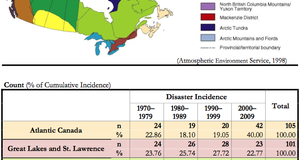Climate Change Negotiations in Montreal, Kyoto, and Copenhagen: Analyzing Negotiation Components and Techniques
By
2012, Vol. 4 No. 02 | pg. 1/1
KEYWORDS:
Climate change negotiations have been on the international stage for almost four decades. They have a complex history, and act as a comprehensive example of the many variables, obstacles, environments, and processes that can affect any international negotiation. This paper examines the structure of international negotiations through the lens of the Montreal (1987), Kyoto (1997), and Copenhagen (2009) climate change talks, addressing such issues as the actors, crises, and phases involved. These three sets of negotiations played out in very different ways as a result of their unique circumstances and places in history, yet each is connected inextricably to the others. When dealing with a global problem such as climate change, a multitude of actors inevitably occupy the stage. As Mark Boyer, Brigid Starkley, and Jonathan Wilkenfeld discuss in their book, International Negotiation in a Complex World, the playing field has widened, encompassing traditional actors such as the state and individual political leaders as well as more recent additions including non-governmental organizations (NGOs), special interest groups, students, the media, domestic constituencies, and “citizen diplomats” (Boyer 2010, 75). Citizen diplomats played a particular role in the Kyoto negotiations, where U.S. vice president Al Gore “gave a much-needed boost to the process” (Boyer 2010, 15) by advocating a more favorable position on the part of the U.S. In Montreal, citizen groups and NGOs “demanded and got the swift negotiation” (Tolba 2007, 7) because of the media and scientific community’s successful attempt to arouse public opinion on the issue. Copenhagen was arguably the most dramatic example of the increasing importance of nontraditional (i.e. non-state) actors, leading Matthew Hoffmann to describe a “Second Copenhagen,” which was a more informal gathering of decentralized, transnational units that he believes are ultimately the key to progress on climate change (Hoffmann 2010, 1). Another key group to any negotiation, but particularly one involving an issue as scientifically technical as climate change, is the epistemic community, or “network of experts” who lend credible knowledge and expertise to the debate (Boyer 2010, 63). In Montreal, this included men like Mario Molina, a chemist and researcher at the University of California in Berkeley, as well as the US Environmental Protection Agency (EPA) and the National Oceanic and Atmospheric Administration, who continue to publish research on their findings related to global warming and climate change (UNEP 2007, 17). Kyoto negotiations were partially due to reports such as the one from the Intergovernmental Panel on Climate Change (IPCC) predicting “rapid and harmful change” if no action was taken (Boyer 2010, 10-11). Though negotiations in Copenhagen are widely criticized for lacking legally binding commitments, the Copenhagen Accord did expressly acknowledge the epistemic community’s conclusions on climate change, a step that eliminated scientific doubt as a potential obstacle (Garicia 2009, 2). Epistemic communities validate the importance of particular negotiations, present hard facts to support or knock down states’ arguments, and raise public awareness and understanding of complex issues, all of which lend negotiations international credence and are likely to catalyze progress.Depending on their roles and potential contributions to negotiations, various actors interact in different ways at different times throughout the negotiation process. The three general stages of negotiation are the pre-negotiation phase, the negotiation phase, and the implementation phase. The third phase depends heavily on the second, which depends heavily on the first; thus the pre-negotiation stage is often considered the most important. This is where domestic constituencies, epistemic communities, and often NGOs can make their voices heard most clearly; they can contribute to position papers, write newsletters, and communicate with media to promote their arguments. Crucially, pre-negotiation is also where coalitions form, wherein actors can harness the “power of allies to enhance a negotiation position” (Boyer 2010, 44). Pre-negotiation phases were crucial in Montreal, Kyoto, and Copenhagen; Montreal was, in fact, the culmination of over 10 years of pre-negotiations. The gaps between these three negotiations were also crucial times for the evolution of states’ policies, technology development, and the evolution of the international system, all of which affected the character and potential of the negotiations themselves. The negotiation period is often short (only ten days in Copenhagen, which put a severe time crunch on the parties) and acts as the period when previously established positions are presented and incorporated into the working document until “all the participating governments finally reach agreement on the exact wording of all portions of the text” (Sidhu 2007, 21). The fluidity and productivity of this period has much to do with logistics, rules of procedure, and leadership within the negotiations. In Montreal, for example, Mostafa Tolba filled the role of a charismatic Chair who could relate to the G-77 and China on a level that made them comfortable and willing to fully enter negotiations. The same was not true in Copenhagen, where the Danish President, far from “loyally support[ing] the formal process” (Meilstrup 2010, 118), showed no patience for procedure and was eventually replaced, bringing an element of uncertainty and chaos into an already tense environment. In Kyoto we experienced the successful chairmanship of Raul Estrada-Oyuela, who brokered the land breaking final agreement by manipulating procedure to his advantage (Boyer 2010, 20). In the hands of a skilled chair and/or host delegation, the logistics and procedures of negotiations can help facilitate their progress; in the worst case, however, they can prove to be insurmountable stumbling blocks for the parties involved. International negotiations do not, of course, take place in a vacuum. Political, historical, domestic, and economic factors weigh on all of the actors, influencing their positions and decisions. History is important in negotiations in terms of legacy, the historical chain of connections from one session to the next dealing with the same or related issues (Boyer 2010, 59). The Montreal Protocol was built on a long timeline of negotiations which unofficially began in 1976 with UNEP’s call for an international response to ozone depletion, continued through 1981 when the body acted to form a convention on the issue, and finally culminated in 1987 with the signing of the treaty (UNEP 2007, 4). Kyoto was a step in this same process; participating parties used the legacy of the Montreal negotiations to help structure an agreement. They also had the legacy of the IPCC and the United Nations Framework Convention on Climate Change (UNFCCC), which was signed in Rio at the 1992 Earth Summit (Boyer 2010, 11). The UNFCCC enacted annual Conference of the Parties (COP) meetings, which all contribute to the legacy of climate change negotiations, before and after Kyoto. Negotiators hoped to use this legacy successfully in Copenhagen to build a treaty as strong as Kyoto. Between Kyoto and Copenhagen, negotiations such as the COP 13 in Bali also affected Copenhagen’s legacy; the slow pace of progress and lack of compromise in these COPs set the stage for the struggle in Copenhagen. The legacy of any negotiation relates to the political situation in which each set of negotiations took place. The Cold War was a defining factor of international relations from the beginning of climate change talks, and its end, marked by the collapse of the Soviet Union, brought new factors into play. One such is globalization. The economic interdependence and disparities in wealth often attributed to globalization resulted in the “Global North” (developed countries such as the U.S. and France) and “Global South” (many African and Latin American states). This “growing divide between the haves and the have-nots” (Stiglitz 2002, 5) resulted in an imbalance of power favoring the North and thereby putting the South at a disadvantage in negotiations. Montreal occurred under the Cold War system, but we saw the affects of globalization in Kyoto and Copenhagen with the relative domination of the U.S., European Union (EU), and mid-level states like China and Brazil over smaller coalitions like the African Union (AU) and the Alliance of Small Island States (AOSIS). This was particularly evident on the last night of debate in Copenhagen, when the leaders of the U.S., Brazil, China, India, and South Africa brokered a deal in a private meeting; many developing countries “furiously refus[ed] to adopt a…document…that had been negotiated in ‘secret’” (Meilstrup 2010, 132). A second post-Cold War factor in negotiations is globalized media and the revolution in communications technology. The instantaneous nature of communication allows non-state actors like NGOs and individuals to be heard strongly around the world, as was the case in Kyoto. NGOs “used the Internet to broadcast news and analysis;” Al Gore stole media spotlight with his “rescue mission” (Boyer 2010, 15). Media puts the events and actors in full public view, and has immense power to influence public opinion. This was the case in Copenhagen as well, where “significant bottom-up change and innovation” was possible through internationally mobilized groups like Greenpeace; prominent media figures like Thomas Friedman also significant individual presences (Garcia 2009, 2). The last and arguably most important result of the end of the Cold War was the dissolution of the bipolar power structure. “Polarity” refers to the way power is distributed among states; during the Cold War the U.S. and Russia were the opposite ends of a bipolar system; today many states vie for top spots, resulting in a multipolar “diffusion of…decision-making” where many groups who have the power to substantially influence negotiations (Boyer 2010, 37). The Montreal negotiations came at the tail end of bipolarity, when other states were beginning to flex political muscles; this new system became evident in Kyoto, where developed countries, the Group of 77, and AOSIS were all recognized as key players (Boyer 2010, 14). In Copenhagen the complexity of this system led to extreme tensions and debate among all of the factions, with little willingness to move shown by the majority of the many influential states. This staunch resolve to stick to positions comes from a variety of places, one of which is within the state itself. While some international relations theorists perceive states as single voices with unified positions, the truth is that complex domestic stakes can and do divide states. China is one example; their strong business constituency objects to a climate change treaty’s “potential negative effects on commercial competitiveness” (Boyer 2010, 97) a position that the Chinese government sympathizes with, since so much of the newly successful Chinese economy depends on its business sector. This point was salient in Kyoto and even more so in Copenhagen, limiting the concrete progress that could be made. The negotiations in Montreal managed to avoid this diplomatic stalemate, largely due to the perception of crisis that surrounded them. Crises mobilizes complex, sluggish processes with a combination of “threat, time pressure, and stress” (Boyer 2010, 39); states feel the need to take action to protect the security of their people, and are therefore more open to influence by other actors and are more willing to shift their positions to reach agreement. The discovery of the ozone hole in 1985 prompted swift action from states, resulting in the comprehensive Montreal Protocol banning chlorofluorocarbons (CFCs), which caused much of the damage (UNEP 2007, 4). Kyoto and Copenhagen notably had no such air of crisis; Kyoto has been described as “a way around serious action” by some (Boyer 2010, 20), and Copenhagen received scathing criticisms calling it “the worst development in climate change negotiating history” (Levi 2009, 1). The presence of an immediately threatening crisis, or the interpretation of our current situation in this way, may be what is necessary to catalyze future negotiations. International negotiations can be basically classified as competitive negotiations or collaborative negotiations. Competitive negotiations rest on the inherent lack of trust built into the international state system, resulting in moves like positional bargaining, adversarial diplomacy, and coercive diplomacy used as negative incentives between states (Boyer 2010, 131-133). Collaborative negotiations are based on recognition of a common goal; actors attempt to “emphasize common ground while downplaying areas of contention” (Boyer 2010, 134). Climate change negotiations can be said to fall somewhere in the middle; presumably states realize that they all have the common goal of preserving the planet for future generations of citizens, but the radical differences in their methods and priorities on the way can cause a competitive environment. The crisis in Montreal eclipsed this competitive inclination, but it resurfaced in Kyoto and Copenhagen as parties laid out their stances and defended them by laying blame on others. This kind of political face-saving and subtle (or not so subtle in some cases) slandering of other states is clearly a negative incentive for action on their part. Negotiations are intertwined with world events, actors, stakes, and historical processes; it is absolutely impossible to separate them from their environments. Therefore, in order to increase the productivity and maximize the results of international negotiation sessions, we must create an environment in which it is in actors’ best interests to work collaboratively and willingly contribute what each of them can bring to the table. The juggling of NGOs, states, domestic constituencies, unpredictable crises, cultural differences, historical relationships, and economic circumstances is delicate and obviously extraordinarily complex, but this is the most basic nature and goal of negotiating in a global, interdependent world. In order to accomplish this lofty goal, emphasis must be placed on the power and capability of non-state actors such as NGOs to catalyze events. As Matthew Hoffmann opines, “it will be near impossible to catalyze the kind of societal-economic-energy system transformation deemed necessary through global treatymaking” as it has existed; he suggests decentralizing the weight of negotiations, laying the onus on dedicated non-state actors while states use traditional negotiation to address smaller logistical or legal issues (Hoffmann 2010, 1). This is one potential option for the transition to collaborative negotiation that has promise, however there are others, and it will take dedication, ingenuity, and flexibility to discover the process that will most effectively create progress. ReferencesBoyer, M. and Starkley, B. and Wilkenfeld, J. (2010) International Negotiation in a Complex World, 2nd ed. Lanham: The Rowman & Littlefield Publishers, Inc. Garcia, D. (2009) Personal Reflections on Copenhagen United Nations Climate Change Conference, Political Science News, Boston: Northeastern University. Hoffman, M. (2010) A Tale of Two Copenhagens, Lecture, unpublished. Levi, M. and Loy, F. (2009) ‘The Road From Copenhagen,’ New York Times, New York: The New York Times Company. Meilstrup, P. (2010) ‘The Runaway Summit: The Background Story of the Danish Presidency of COP15, the UN Climate Change Conference,’ 113-135, Danish Foreign Policy Yearbook 2010, Copenhagen: Danish Institute for International Studies (DIIS). Sidhu, G. (2007) Intergovernmental Negotiations and Decision Making at the United Nations: A Guide. Second Updated Edition, New York and Geneva: UN Non-Governmental Liaison Service (NGLS). Stiglitz, J. (2002) Globalization and Its Discontents, W.W. Norton & Company Tolba, M. (2007) ‘Lessons Learned’ The Art Of Diplomacy: Celebrating 20 years of The Montreal Protocol, 6-7. Our Planet, Nairobi: UNEP Division of Communications and Public Information. United Nations Environment Programme (UNEP). (2007) The Art Of Diplomacy: Celebrating 20 years of The Montreal Protocol, Our Planet, Nairobi: UNEP Division of Communications and Public Information. Suggested Reading from Inquiries Journal
Inquiries Journal provides undergraduate and graduate students around the world a platform for the wide dissemination of academic work over a range of core disciplines. Representing the work of students from hundreds of institutions around the globe, Inquiries Journal's large database of academic articles is completely free. Learn more | Blog | Submit Latest in International Affairs |


















